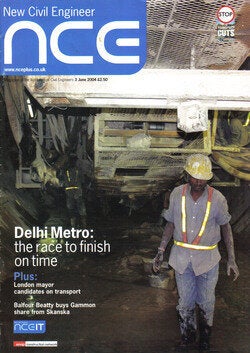I studied civil engineering at University, worked in an engineering design practice and now write about infrastructure for a living. So as a woman in this particular segment of engineering I am pleased to see the opportunities in the industry being celebrated this week by the Women's Engineering Society.
Established in 1919 the WES supported pioneering women who had entered engineering industries during World War 1 only to be pushed out when the war ended. Celebrating 95 years of work WES launched the first annual National Women in Engineering Day (NWED) in 2014 and the second NWED will take place this week.
Having spoken to hundreds of female engineers since I graduated in 2001 I can honestly say that having an engineering degree opens a world of opportunities. Women in civil engineering have told me how much they love their varied, challenging and interesting work. They say that every day is different and they are proud that their work is improving - even saving - lives all over the world by designing and implementing water networks and sewerage systems, providing roads and new rail links, creating low energy buildings, saving communities from flooding and developing sustainable energy solutions.
But I have also been told that low numbers of senior women in engineering mean a lack of mentors and role models for the increasing number of females choosing to come into the engineering industries. Female engineers have told me that they fear that unconscious bias is preventing the advancement of female professionals and in some unfortunate cases they report that men in their companies talk over them, don't listen to them, and cut them off mid-sentence. Thankfully this is rare, but it happens and some companies are better than others at supporting the women who remain a minority in their male dominated businesses. According to the Institution of Engineering and Technology (IET) 43% of companies are failing to support diversity in their companies and women represent just 6% of the engineering workforce
There are also some more unusual issues that women in the built environment have to contend with. On a personal level one of the most interesting experiences I ever had was visiting India's Delhi Metro to write an article about it in 2004. Building an underground railway means digging tunnels, in this case 10m wide and 9m tall passageways, and as I was lowered into the shaft which would take me 30m below the bustling streets of India's capital the men who were working at the face of the excavation looked at me in horror. They were literally backing away from me with fear in their eyes, and although my husband jokes that this was a completely understandable reaction, it made me so deeply uncomfortable that I asked the supervising engineer what was happening. He told me that some of the workers believed that having a woman in the tunnel was bad luck - they were superstitious, he said.

I am not the only one to experience this. A female tunnelling engineer in Hong Kong told me that ten years ago she had been made to wait outside a tunnel that she had designed as her male counterparts visited the excavation. And former Prime Minister of New Zealand Helen Clark revealed in her Valedictory speech of 2009 that she was prevented from entering the Kaimai railway tunnel during construction in the 1970s because the Irish and Italian tunnellers had the same fears.
It seems that the origin of such superstition is a combination of legislative rulings and tunnel incidents in the mining industry where modern tunnelling originated. The Mining and Colliers Act 1842 prohibited all females and boys under ten from working underground as Victorians sought to prevent the exploitation of women and children in the dangerous coal mining industry of the early 19th century.
Still mining remained a high risk business and a great deal of superstition developed around working underground. Whenever a collapse, gas leak or explosion occurred women would flock to the mines looking for their loved ones and so women near a mine were then considered a bad omen.
Fortunately tunnellers can't afford to hold on to sexist superstitions as the boom in demand for new tunnels means that female engineers are a much needed resource. "You can't tell a woman not to enter the tunnel if she is paying you," pointed out one female engineer. And another told me how much she loves her work building some of the world's biggest railways, sewers and roads. "I am a tunneller through and through and very proud of my industry and how we contribute to build a better society. Women, nowadays, play a key role in this," says Rosa Diez, a geotechnical engineer and project manager for tunnelling at consultant Mott MacDonald.
In fact women today play a key role in all engineering sectors and this is growing with professional institutions and companies alike reporting rising numbers of female graduates coming into their professions. Firms are acknowledging that companies with a higher proportion of women at senior levels are more profitable, while at the same time realising that promoting the industry to women is a vital tactic in bringing more bright people into a growing sector. This means encouraging more women into engineering, supporting those that work in it and promoting those that are good at it. Those that don't do this will be left behind.
For more see my blog: www.bernadetteballantyne.com and for more stories on women in engineering go to www.infrastructure-intelligence.com
